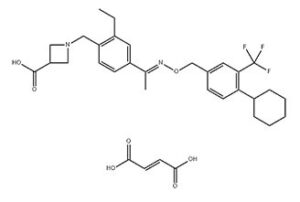Siponimod fumarate (BAF312)
This product is for research use only, not for human use. We do not sell to patients.

For small sizes, please check our retail website as below: www.invivochem.com
| Size | Price | Stock |
|---|---|---|
| 500mg | $1020 | Check With Us |
| 1g | $1850 | Check With Us |
| 5g | $4995 | Check With Us |
Cat #: V17399 CAS #: 1234627-85-0 Purity ≥ 98%
Description: Siponimod fumarate (BAF-312) is a novel, potent and orally bioavailable S1P receptor modulator.
Top Publications Citing Invivochem Products
Publications Citing InvivoChem Products
Product Promise

- Physicochemical and Storage Information
- Protocol
- Related Biological Data
- Stock Solution Preparation
- Quality Control Documentation
| Molecular Weight (MW) | 632.68 |
|---|---|
| Molecular Formula | C33H39F3N2O7 |
| CAS No. | 1234627-85-0 |
| Protocol | In Vitro | In vitro activity: BAF312 (Siponimod) is a potent and selective S1P receptor agonist, with EC50 of 0.39 nM and 0.98 nM for S1P1 and S1P5receptors, exhibits >1000-fold selectivity over S1P2, S1P3 and S1P4 receptors. BAF312 (1 h at 1 μM) promotes prominent internalization of S1P1 receptors by 91%. Kinase Assay: The cells are homogenized and centrifuged at 26900 × g for 30 min at 4°C. Membranes are re-suspended in 20 mM HEPES (pH 7.4), 100 mM NaCl, 10 mM MgCl2, 1 mM EDTA and 0.1% fat-free BSA at 2–3 mg protein/mL. GTPγ[35S] binding assay is performed with the membranes (75 mg protein /mL in 50 mM HEPES, 100 mM NaCl, 10 mM MgCl2, 20 μg/mL saponin and 0.1% fat-free BSA (pH 7.4), 5 mg/mL with wheat-germ agglutinin-coated scintillation proximity assay-bead, and 10 μM GDP for 10–15 min. The GTPγ[35S]-binding reaction is started by the addition of 200 pM GTPγ[35S]. After 120 min at room temperature, the plates are centrifuged for 10 min at 300 × g and counted. Cell Assay: Agonist-mediated internalization of S1P1 receptors in CHO cells analysed by flow cytometry Myc-tag hS1P1 cells are incubated for 1 h with agonist at 37°C in standard culture medium followed by a PBS wash. An aliquot is kept on ice for 3 h, while another aliquot is left for 3 (or 12) h in culture medium (no agonist) at 37°C. The cells are then incubated either with 4 μg/mL monoclonal mouse anti C-myc IgG1 antibody or with isotype control mouse IgG1 for 60 min at 4°C, followed by an incubation with 1 μg/mL of Alexa488-labelled goat anti-mouse secondary conjugates. The cells are subjected to flow cytometry measurements using 10000 viable cells per sample. |
|---|---|---|
| In Vivo | BAF312 effectively suppresses encephalomyelitis (EAE) in rats by internalizing S1P1 receptors, rendering them insensitive to the egress signal from lymph nodes. BAF312 significantly reduces clinical scores when dosed prophylactically or therapeutically in mice at 0.3 mg/kg. | |
| Animal model | Encephalomyelitis (EAE) model rat |
These protocols are for reference only. InvivoChem does not
independently validate these methods.
| Solvent volume to be added | Mass (the weight of a compound) | |||
|---|---|---|---|---|
| Mother liquor concentration | 1mg | 5mg | 10mg | 20mg |
| 1mM | 1.5806 mL | 7.9029 mL | 15.8058 mL | 31.6116 mL |
| 5mM | 0.3161 mL | 1.5806 mL | 3.1612 mL | 6.3223 mL |
| 10mM | 0.1581 mL | 0.7903 mL | 1.5806 mL | 3.1612 mL |
| 20mM | 0.0790 mL | 0.3951 mL | 0.7903 mL | 1.5806 mL |
The molarity calculator equation
Mass(g) = Concentration(mol/L) × Volume(L) × Molecular Weight(g/mol)
Mass
=
Concentration
×
Volume
×
Molecular Weight*
The dilution calculator equation
Concentration(start)
×
Volume(start)
=
Concentration(final)
×
Volume(final)
This equation is commonly abbreviated as: C1 V1 = C2 V2
Concentration(start)
C1
×
Volume(start)
V1
=
Concentration(final)
C2
×
Volume(final)
V2
Step One: Enter information below
Dosage mg/kg
Average weight of animals g
Dosing volume per animal µL
Number of animals
Step Two: Enter the in vivo formulation
%DMSO
+
%
+
%Tween 80
+
%ddH2O
Calculation Results:
Working concentration:
mg/ml;
Method for preparing DMSO master liquid:
mg
drug pre-dissolved in
µL
DMSO(Master liquid concentration
mg/mL)
,Please contact us first if the concentration exceeds the DMSO solubility of the batch of drug.
Method for preparing in vivo formulation:
Take
µL
DMSO master liquid, next add
µL
PEG300, mix and clarify, next add
µL
Tween 80,mix and clarify, next add
µL
ddH2O,mix and clarify.
Note:
- (1) Please be sure that the solution is clear before the addition of next solvent. Dissolution methods like vortex, ultrasound or warming and heat may be used to aid dissolving.
- (2) Be sure to add the solvent(s) in order.




































